Influence of the Heating System on the Indoor Environmental Quality—Case Study
Abstract
:1. Introduction
2. Materials and Methods
2.1. Location
2.2. Object
2.3. Layout of the Administrative Building
2.4. Construction-Technical Design
2.5. Heating and Cooling
2.6. Monitored Meeting Room
3. Results
3.1. Thermal-Humidity Microclimate
3.2. CO2 Concentrations
3.3. PM Concentrations
3.4. VOC Concentrations
4. Conclusions
Author Contributions
Funding
Institutional Review Board Statement
Informed Consent Statement
Data Availability Statement
Conflicts of Interest
References
- Danza, L.; Barozzi, B.; Bellazzi, A.; Belussi, L.; Devitofrancesco, A.; Ghellere, M.; Salamone, F.; Scamoni, F.; Scrosati, C. A weighting procedure to analyse the Indoor Environmental Quality of a Zero-Energy Building. Build. Environ. 2020, 183, 107155. [Google Scholar] [CrossRef]
- Catalina, T.; Iordache, V. IEQ assessment on schools in the design stage. Build. Environ. 2012, 49, 129–140. [Google Scholar] [CrossRef]
- Akunmu, W.P.; Nunayon, N.S.; Eboson, U.C. Indoor environmental quality (IEQ) assessment of Nigerian university libraries: A pilot study. Energy Built Environ. 2021, 2, 302–314. [Google Scholar] [CrossRef]
- Pollard, B.; Held, F.; Engelen, L.; Powell, L.; de Dear, R. Data fusion in buildings: Synthesis of high-resolution IEQ and occupant tracking data. Sci. Total Env. 2021, 776, 146047. [Google Scholar] [CrossRef]
- Shum, C.; Alipouri, Y.; Zhong, L. Examination of human interaction on indoor environmental quality variables: A case study of libraries at the University of Alberta. Build. Environ. 2022, 20, 108476. [Google Scholar] [CrossRef]
- Ren, C.; Cao, S. Development and application of linear ventilation and temperature models for indoor environmental prediction and HVAC systems control. Sustain. Cities Soc. 2019, 51, 101673. [Google Scholar] [CrossRef]
- Awada, M.; Srour, I. A genetic algorithm based framework to model the relationship between building renovation decisions and occupants’ satisfaction with indoor environmental quality. Build. Environ. 2018, 146, 247–257. [Google Scholar] [CrossRef]
- Wu, J.; Li, X.; Li, Y.; Yan, Y.; Tu, J. A PMV-based HVAC control strategy for office rooms subjected to solar radiation. Build. Environ. 2020, 177, 106863. [Google Scholar] [CrossRef]
- Jain, N.; Burman, E.; Stamp, S.; Mumovic, D.; Davies, M. Cross-sectoral assessment of the performance gap using calibrated building energy performance simulation. Energy Build. 2020, 224, 110271. [Google Scholar] [CrossRef]
- Bellia, L.; Alfano, R.; Alfano, R.D’.; Fragliasso, F.; Palella, B.I.; Ricco, G. On the interaction between lighting and thermal comfort: An integrated approach to IEQ. Energy Build. 2021, 231, 110570. [Google Scholar] [CrossRef]
- Parkinson, T.; Parkinson, A.; de Dear, R. Continuous IEQ monitoring system: Context and development. Energy Build. 2019, 149, 15–25. [Google Scholar] [CrossRef] [Green Version]
- Residovic, C. The New NABERS Indoor Environment tool—the next frontier for Australian buildings. Procedia Eng. 2017, 180, 303–310. [Google Scholar] [CrossRef]
- Monge-Barrio, A.; Bes-Rastrollo, M.; Dorregaray-Oyeregui, S.; González-Martínez, P.; Martin-Calvo, N.; López-Hernández, D.; Arriazu-Ramos, A.; Sánchez-Ostiz, A. Encouraging natural ventilation to improve indoor environmental conditions at schools. Case studies in the north of Spain before and during COVID. Energy Build. 2022, 254, 111567. [Google Scholar] [CrossRef]
- Noorinmotlagh, Z.; Jaafarzadeh, N.; Martínez, S.S. A systematic review of possible airborne transmission of the COVID-19 virus (SARS-CoV-2) in the indoor air environment. Environ. Res. 2021, 193, 110612. [Google Scholar] [CrossRef] [PubMed]
- Bluyssen, P.M. Towards an integrated analysis of the indoor environmental factors and its effects on occupants. Intell. Build. Int. 2020, 12, 199–207. [Google Scholar] [CrossRef]
- Bonnefoy, X.R.; Annesi-Maesono, I.; Aznar, L.M.; Braubachi, M.; Croxford, B.; Davidson, M.; Ezratty, V. Review of Evidence on Housing and Health. In Proceedings of the Fourth Ministerial Conference on Environment and Health, Budapest, Hungary, 23–25 June 2004. [Google Scholar]
- Howook, S.C.; Capuozzo, B.; Okumus, B.; Meehee, C. Why cleaning the invisible in restaurants is important during COVID-19: A case study of indoor air quality of an open-kitchen restaurant. Int. J. Hosp. Manag. 2021, 94, 102854. [Google Scholar]
- Kim, J.; Hong, T.; Kong, M.; Jeong, K. Building occupants’ psycho-physiological response to indoor climate and CO2 concentration changes in office buildings. Build. Environ. 2002, 169, 106596. [Google Scholar] [CrossRef]
- Anand, P.; Cheong, D.; Sekhar, C. A review of occupancy-based building energy and IEQ controls and its future post-COVID. Sci. Total Environ. 2022, 15, 150249. [Google Scholar] [CrossRef]
- Tang, L.; Liu, M.; Ren, B.; Chen, J.; Liu, X.; Wu, X.; Huang, W.; Tian, J. Transmission in home environment associated with the second wave of COVID-19 pandemic in India. Environ. Res. 2022, 204, 111910. [Google Scholar] [CrossRef]
- Choi, J.; Loftness, V.; Aziz, A. Post-occupancy evaluation of 20 office buildings as basis for future IEQ standards and guidelines. Energy Build. 2012, 46, 167–175. [Google Scholar] [CrossRef]
- Khan, D.S.; Kolarik, J.; Hviid, C.A.; Weitzmann, P. Method for long-term mapping of occupancy patterns in open-plan and single office spaces by using passive-infrared (PIR) sensors mounted below desks. Energy Build. 2021, 230, 110543. [Google Scholar]
- Borgstein, E.H.; Lamberts, R.; Hensen, J.L.M. Mapping failures in energy and environmental performance of buildings. Energy Build. 2018, 158, 476–485. [Google Scholar] [CrossRef] [Green Version]
- Lin, B.; Liu, Y.; Wang, Z.; Pei, Z.; Davies, M. Measured energy use and indoor environment quality in green office buildings in China. Energy Build. 2016, 129, 9–18. [Google Scholar] [CrossRef]
- Liu, P.; Lin, B.; Wu, X.; Zhou, H. Bridging energy performance gaps of green office buildings via more targeted operations management: A system dynamics approach. J. Environ. Manag. 2019, 238, 64–71. [Google Scholar] [CrossRef] [PubMed]
- Leyten, J.; Kurvers, R. Robustness of buildings and HVAC systems as a hypothetical construct explaining differences in building related health and comfort symptoms and complaint rates. Energy Build. 2006, 38, 701–707. [Google Scholar] [CrossRef]
- Ncube, M.; Riffat, S. Developing an indoor environment quality tool for assessment of mechanically ventilated office buildings in the UK—A preliminary study. Build. Environ. 2012, 53, 26–33. [Google Scholar] [CrossRef] [Green Version]
- Rasheed, E.O.; Khoshbakht, M.; Baird, G. Time spent in the office and workers’ productivity, comfort and health: A perception study. Build. Environ. 2021, 195, 107747. [Google Scholar] [CrossRef]
- Szczepanik-Ścisło, N.; Ścisło, L. Air leakage modelling and its influence on the air quality inside a garage. E3S Web Conf. 2018, 44, 00172. [Google Scholar] [CrossRef] [Green Version]
- Szczepanik-Ścisło, N.; Ścisło, L. Comparison of CFD and multizone modeling from contaminant migration from a household gas furnace. Atmosphere 2021, 12, 79. [Google Scholar] [CrossRef]
- Ministry of Health. Governmental Regulation Number 259/2008 Coll on Detailed Requirements for Indoor Environment of Buildings and Minimum Requirements for Low-Standard Flats and Accommodation Facilities; Ministry of Health: Bratislava, Slovakia, 2008.
- Weather Underground. Available online: https://www.wunderground.com/history/daily/sk/ko%C5%A1ice/LZKZ/date/2020-2-24 (accessed on 15 June 2022).
- Air Pollution: Real-Time Air Quality Index (AQI). Available online: https://aqicn.org/city/slovakia/kosice/amurska/ (accessed on 15 June 2022).
- Pettenkofer, M.V. Über den Luftwechsel in Wohngebäuden; Literarischartistische Anstalt der Cotta’schen Buchhandlungen: München, Germany, 1858. [Google Scholar]
- Ministry of Health. Governmental Regulation Number 210/2016 Coll on Details of the Requirements for the Indoor Environment of Buildings and of the Minimum Requirements for Lower Standard Dwellings and Accommodation; Ministry of Health: Bratislava, Slovakia, 2016.
- Vilcekova, S.; Estokova, A.; Kridlova Burdova, E.; Budaiova, Z. Investigation of Particulate Matter Concentration in Offices. Fresenius Environ. Bull. 2017, 26, 1225–12333. [Google Scholar]
- Nikmatun, Y.Y.R.; Mohd, T.L.; Dorrena, D.; Noorlin, M.; Fazrul, R.S.; Thunwadee, S. Concentration of particulate matter, CO and CO2 in selected schools in Malaysia. Build. Environ. 2015, 87, 108–116. [Google Scholar]
- Kridlova Burdova, E.; Holosova, M. Monitoring of Particulate Matters in University Library. In Collection of Peer-Reviewed Scientific Works IEI 2019; IEI: Košice, Slovakia, 2019; pp. 67–74. [Google Scholar]
- Srivastava, S.; Zhao, X.; Manay, A.; Chen, Q. Effective ventilation and air disinfection system for reducing coronavirus disease 2019 (COVID-19) infection risk in office buildings. Sustain. Cities Soc. 2021, 75, 103408. [Google Scholar] [CrossRef] [PubMed]
- Kim, J.; Tartarini, F.; Parkinson, T.; Cooper, P.; de Dear, R. Thermal comfort in a mixed-mode building: Are occupants more adaptive? Energy Build. 2019, 203, 109436. [Google Scholar] [CrossRef]
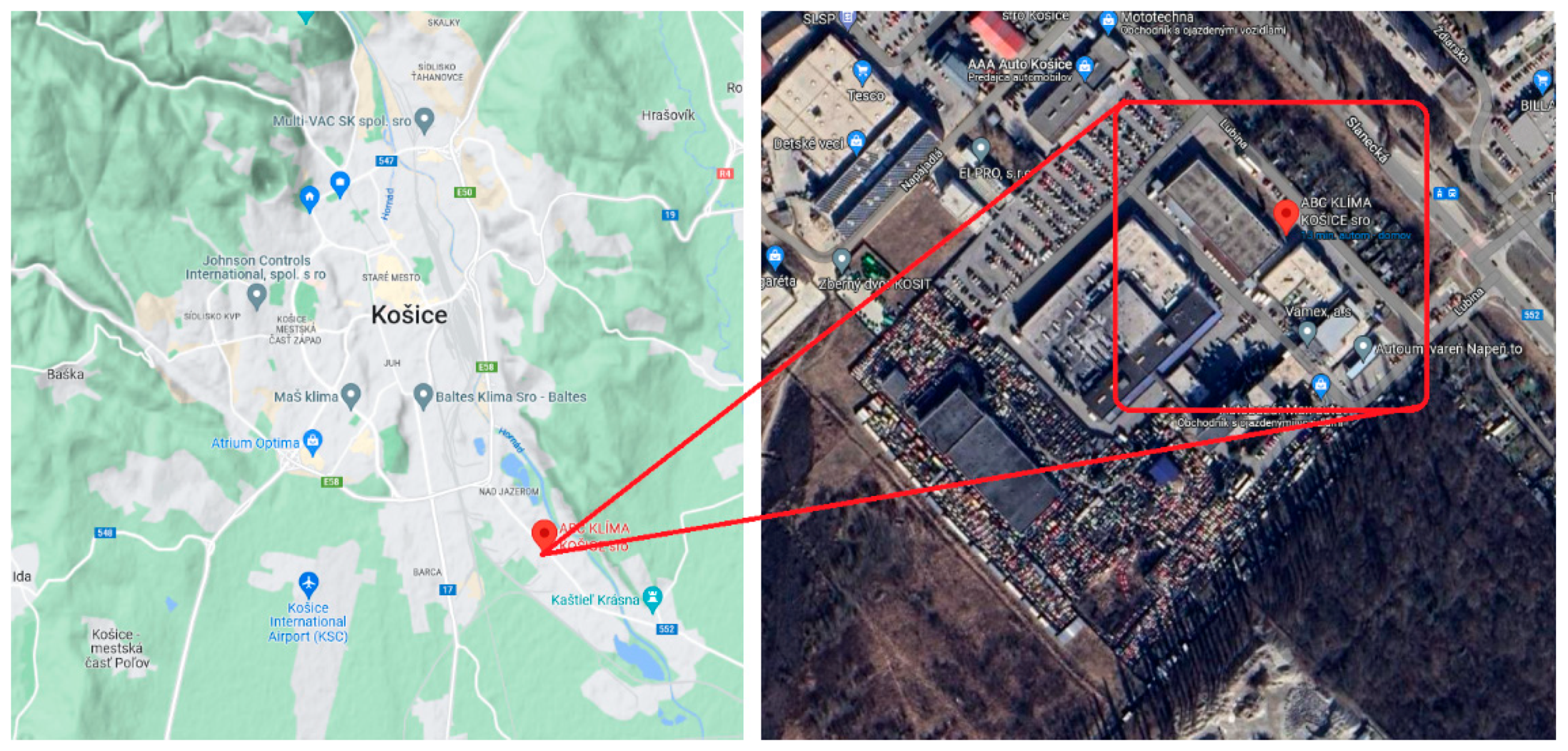
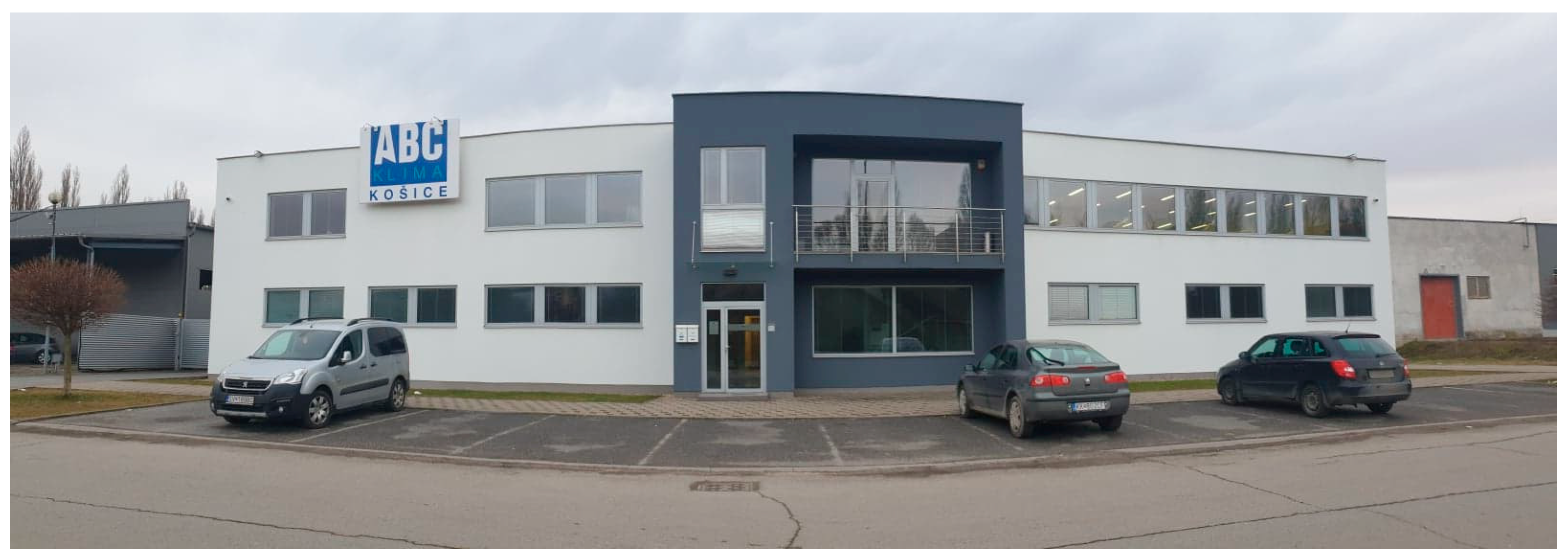

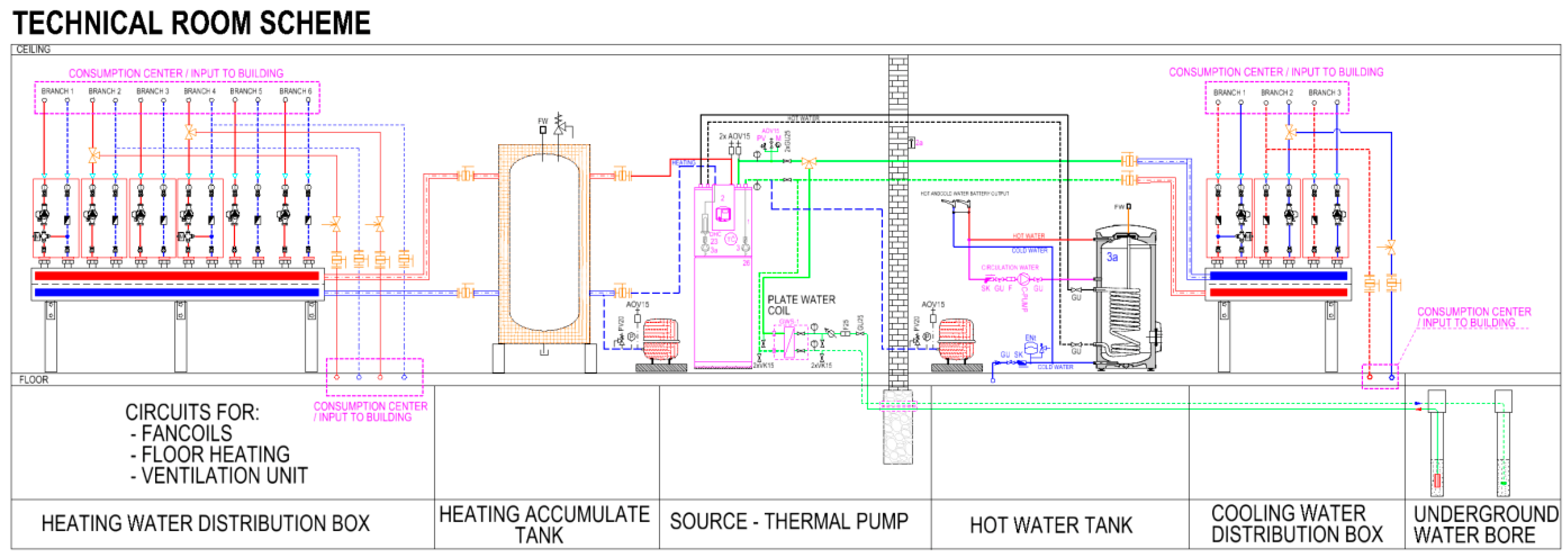
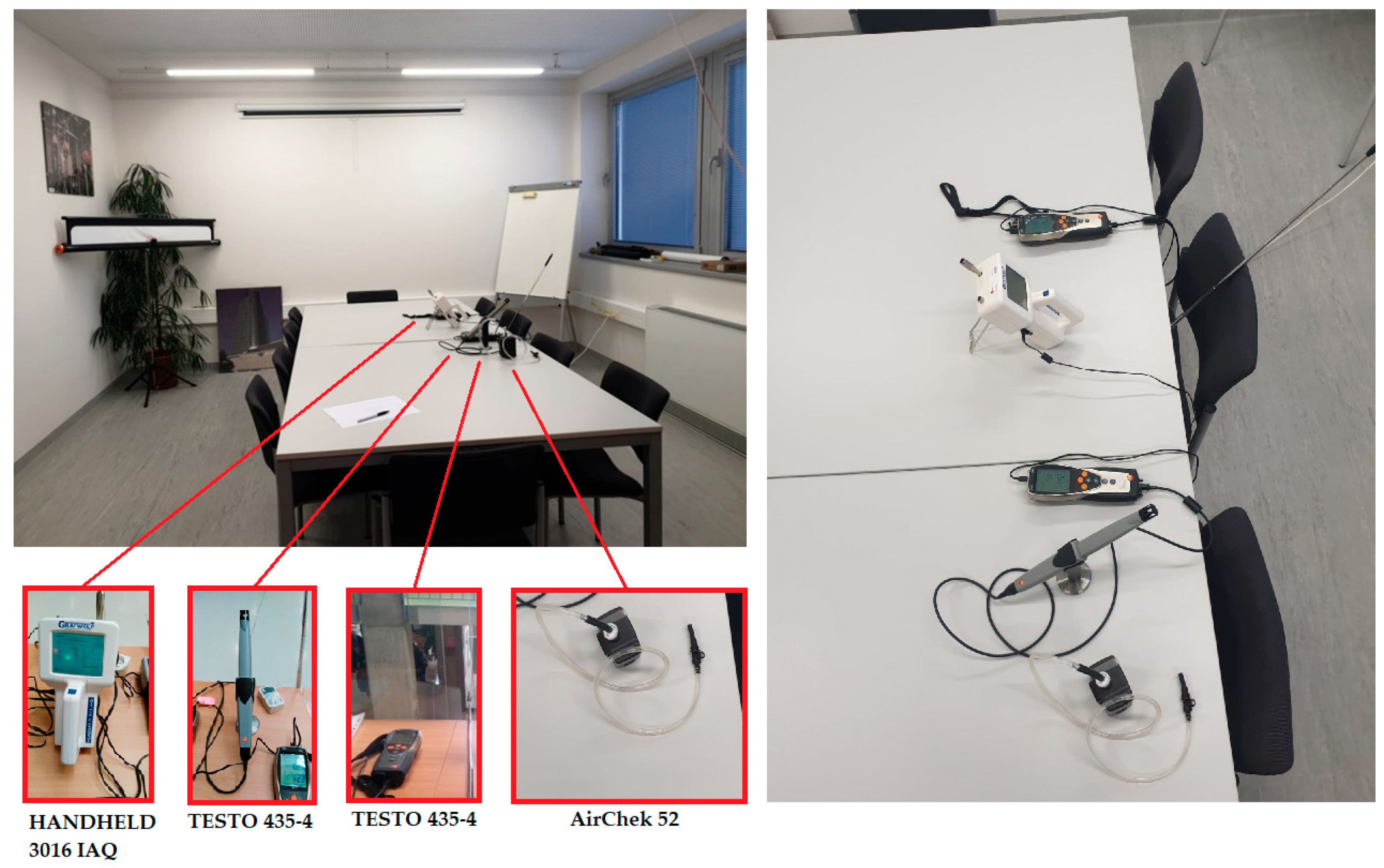
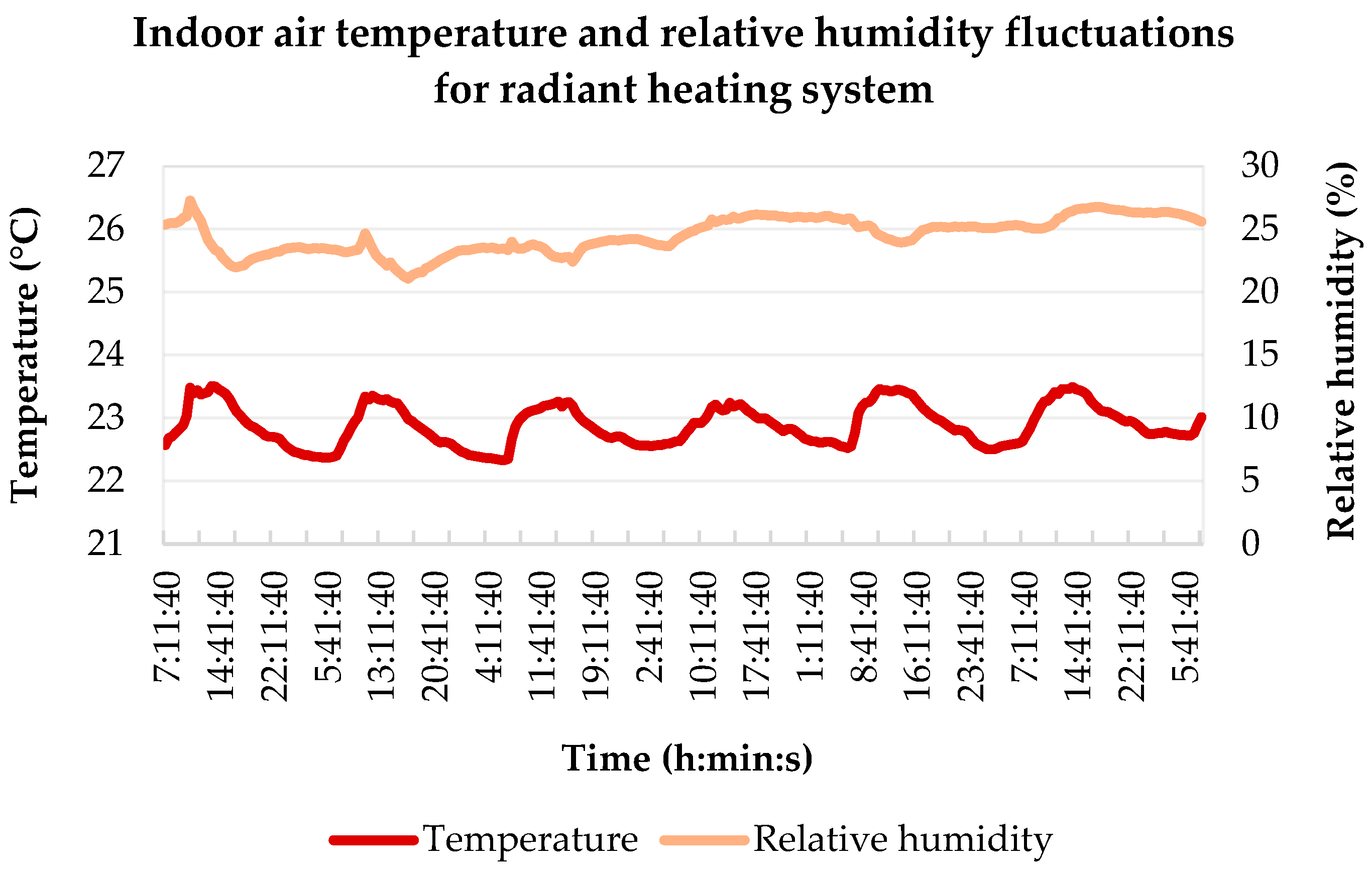
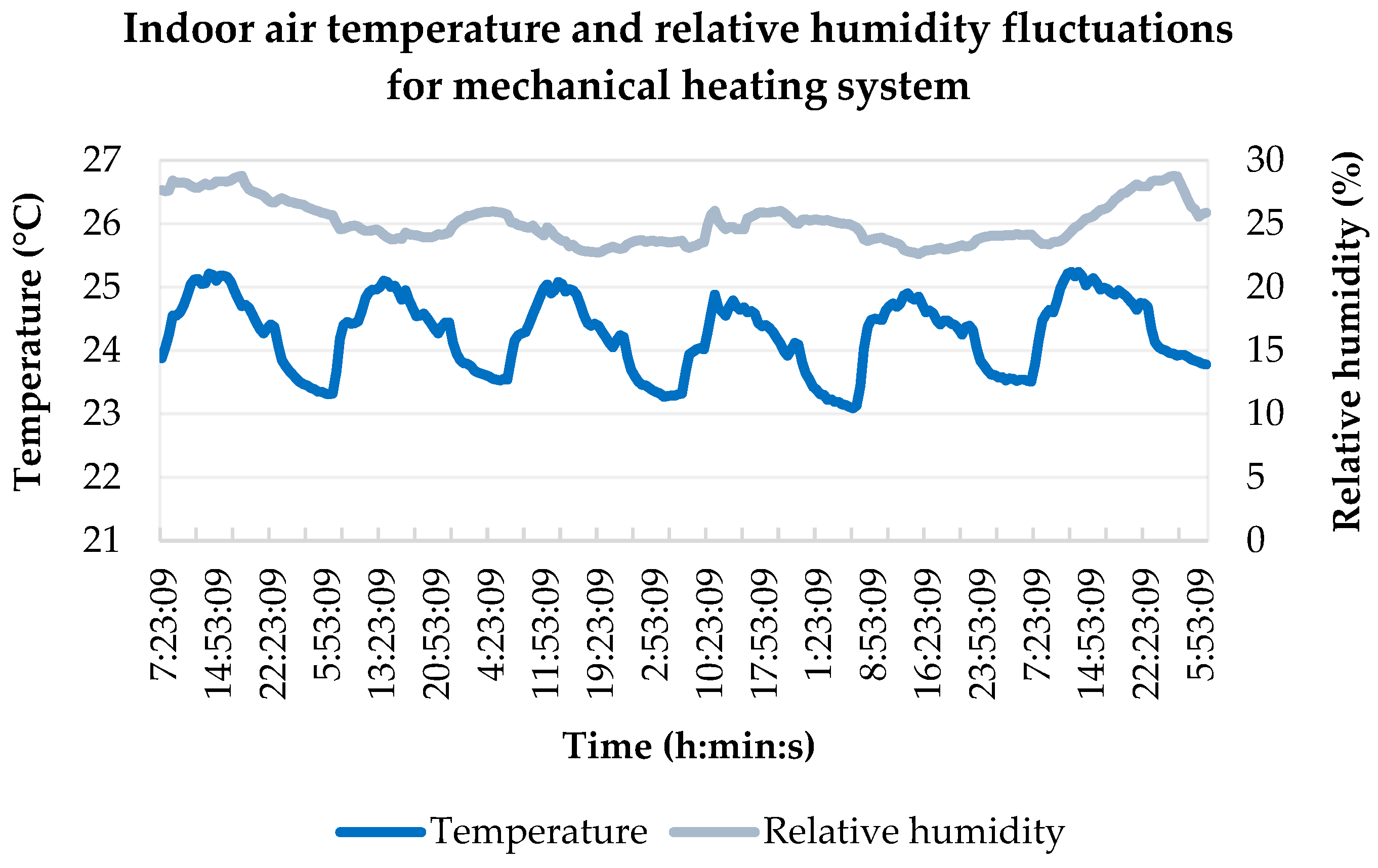
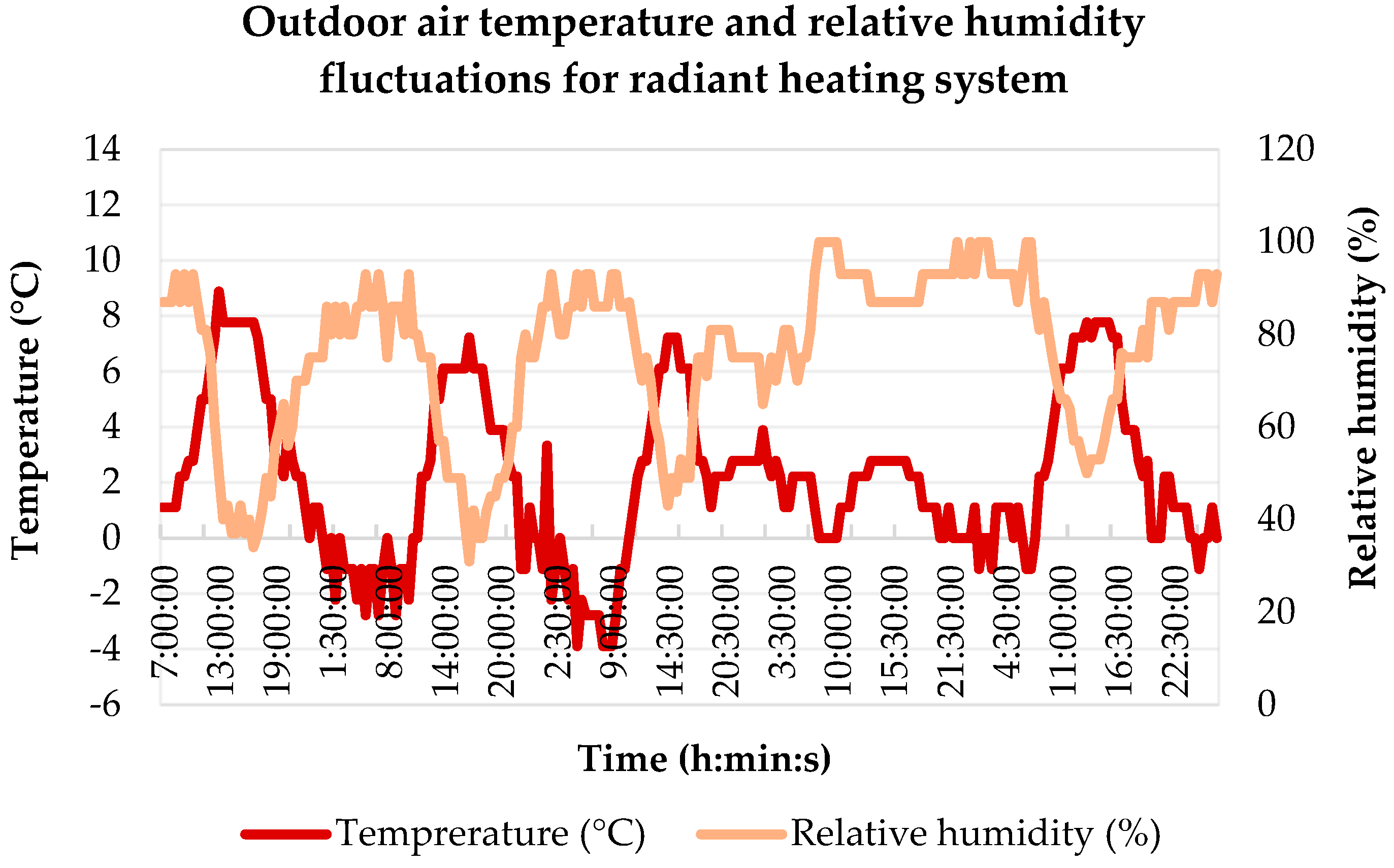
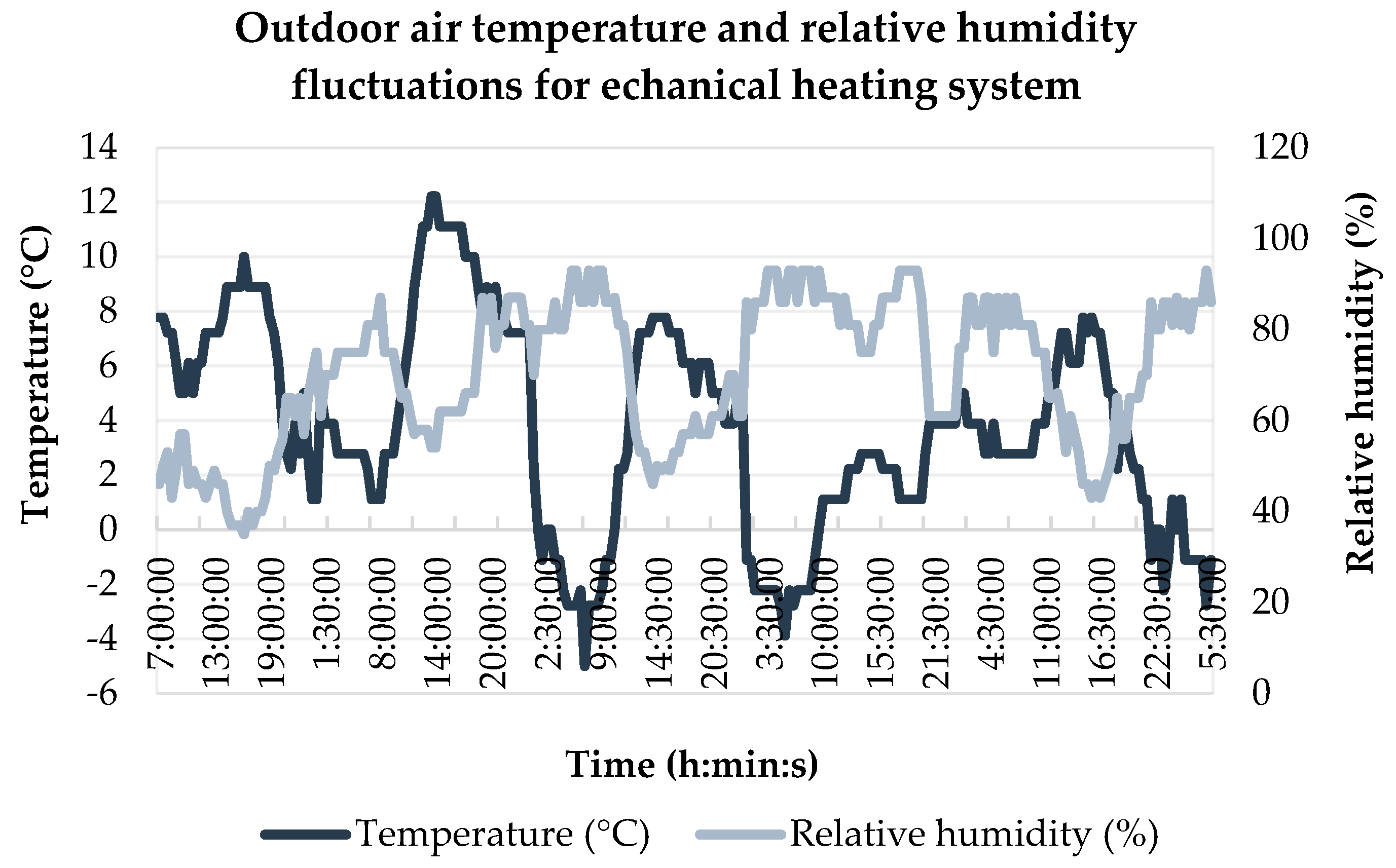
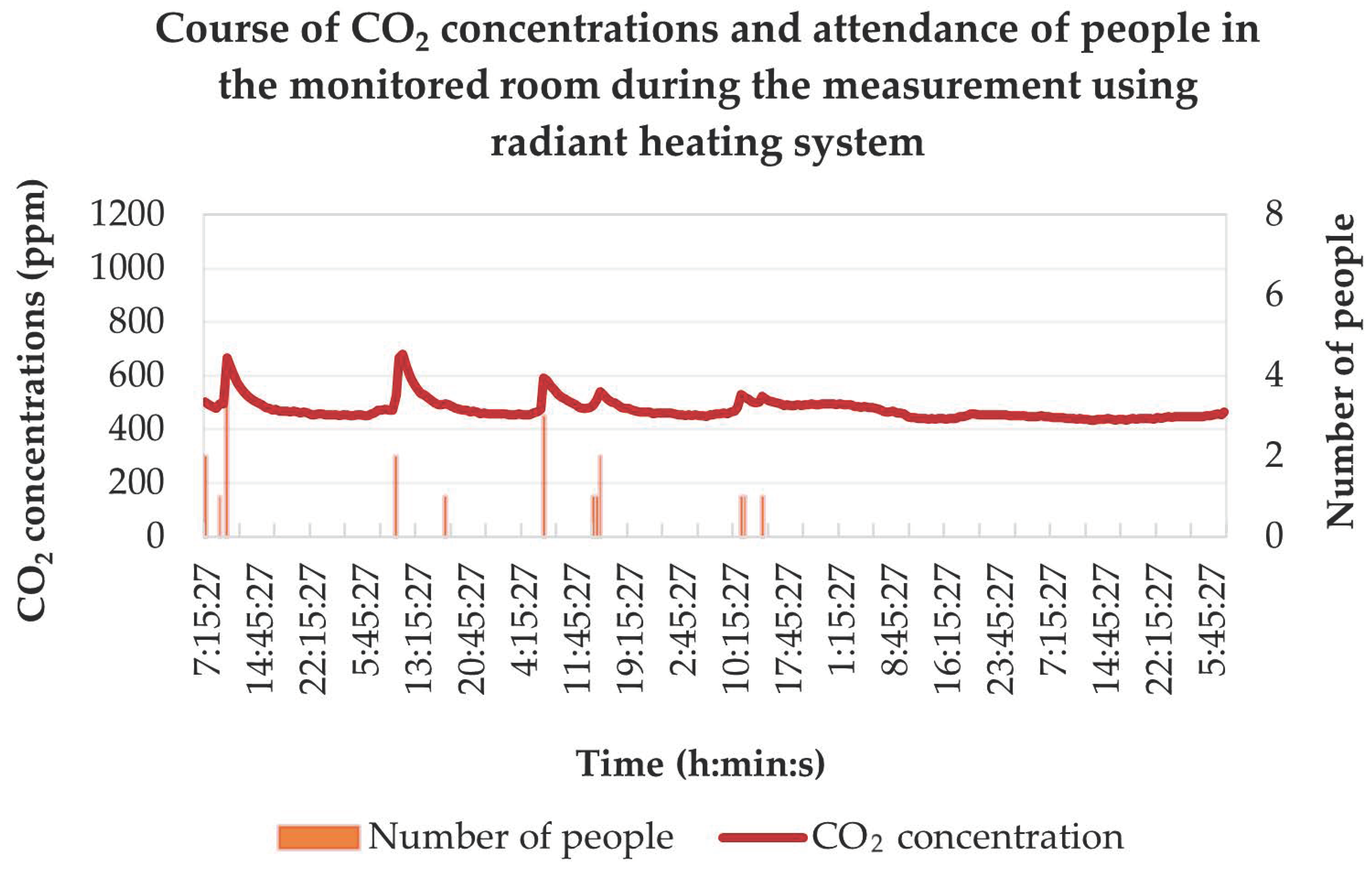
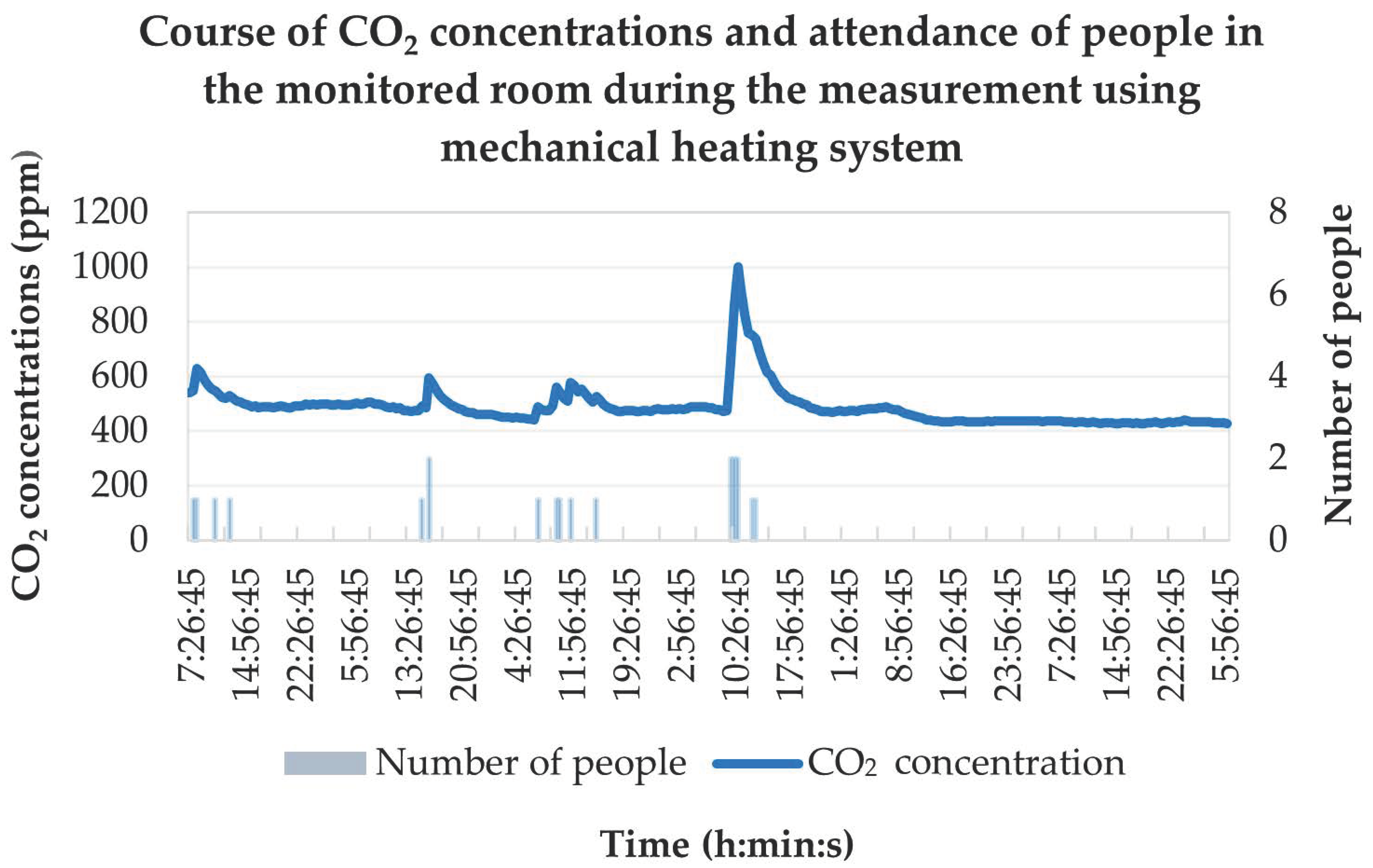
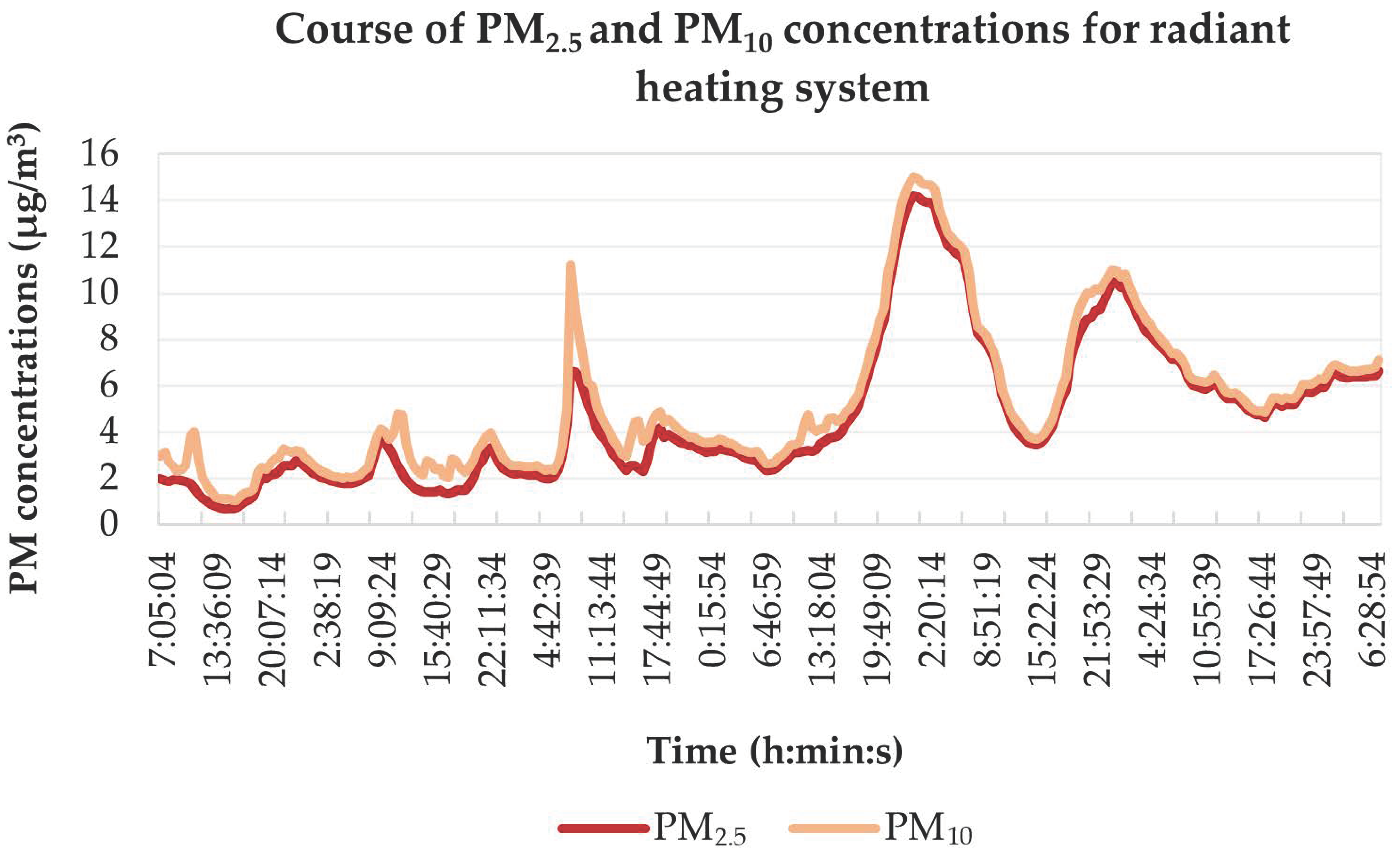

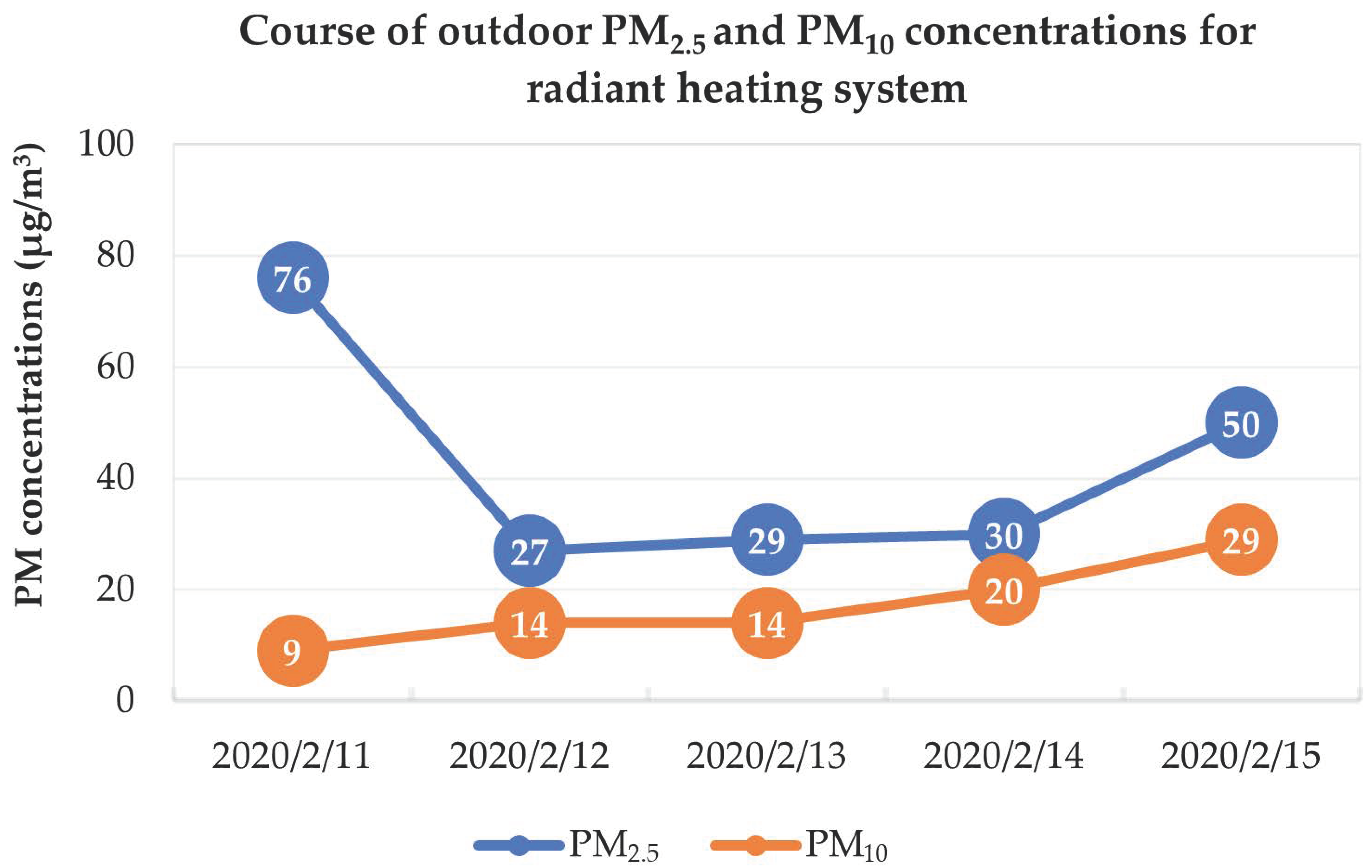
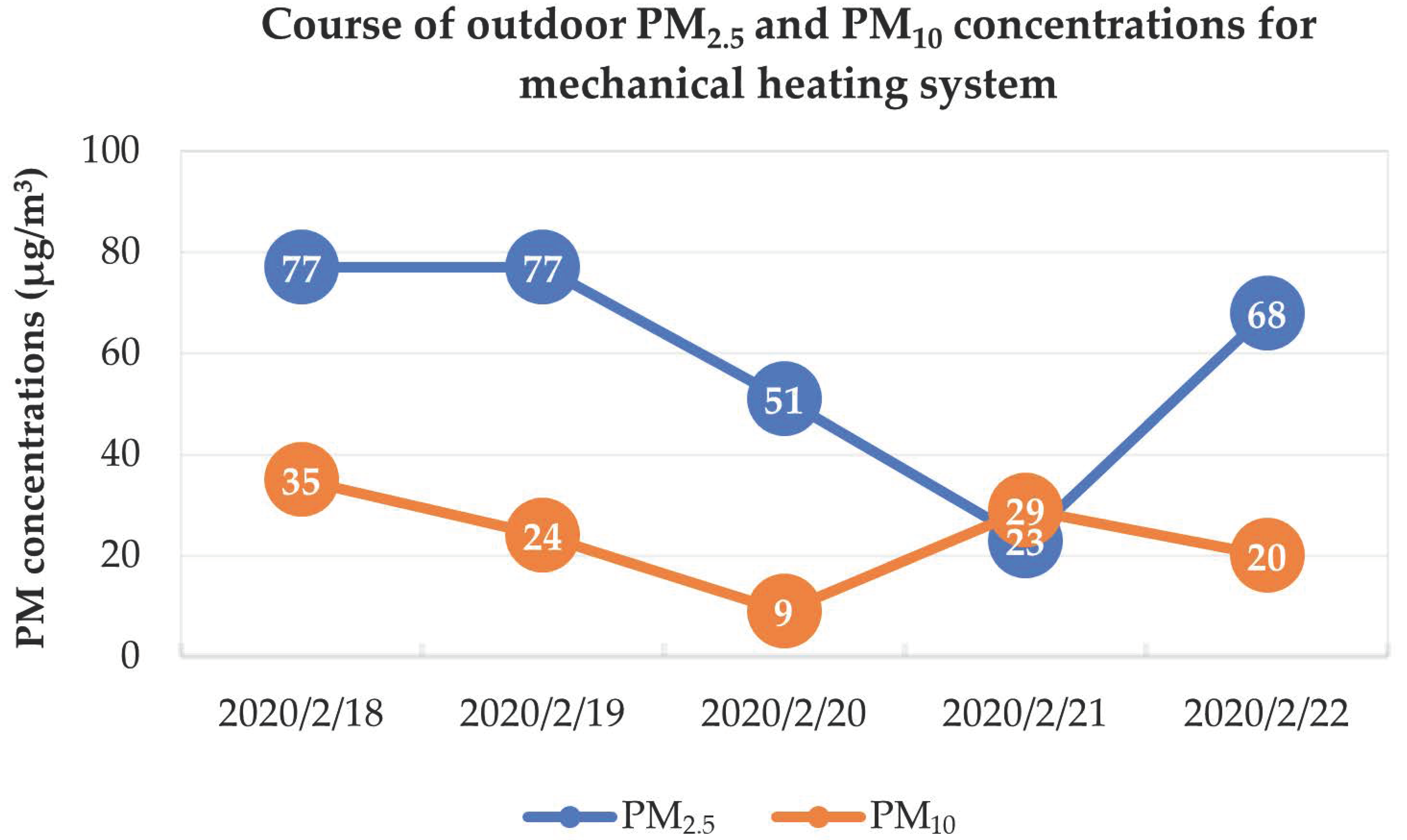
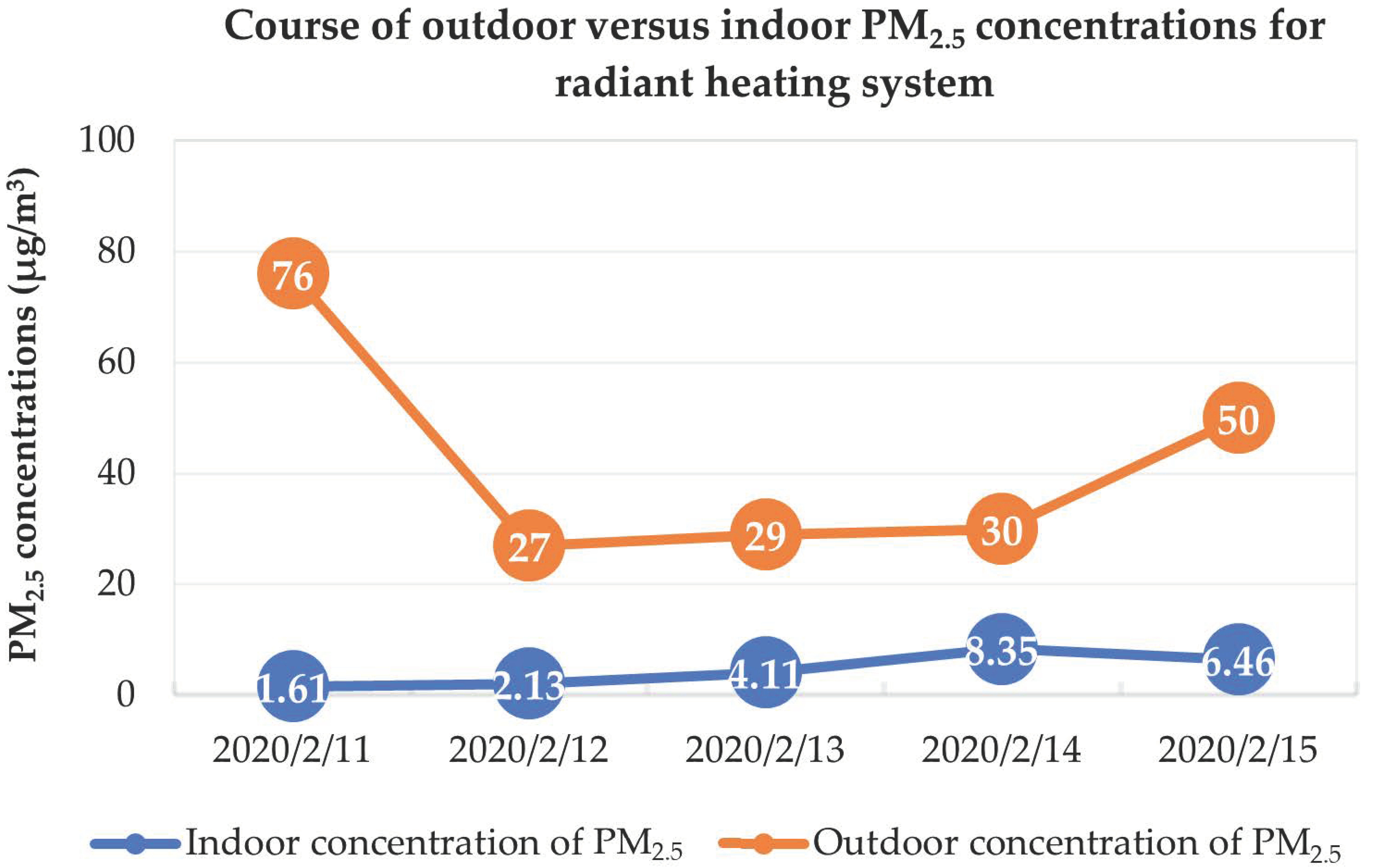
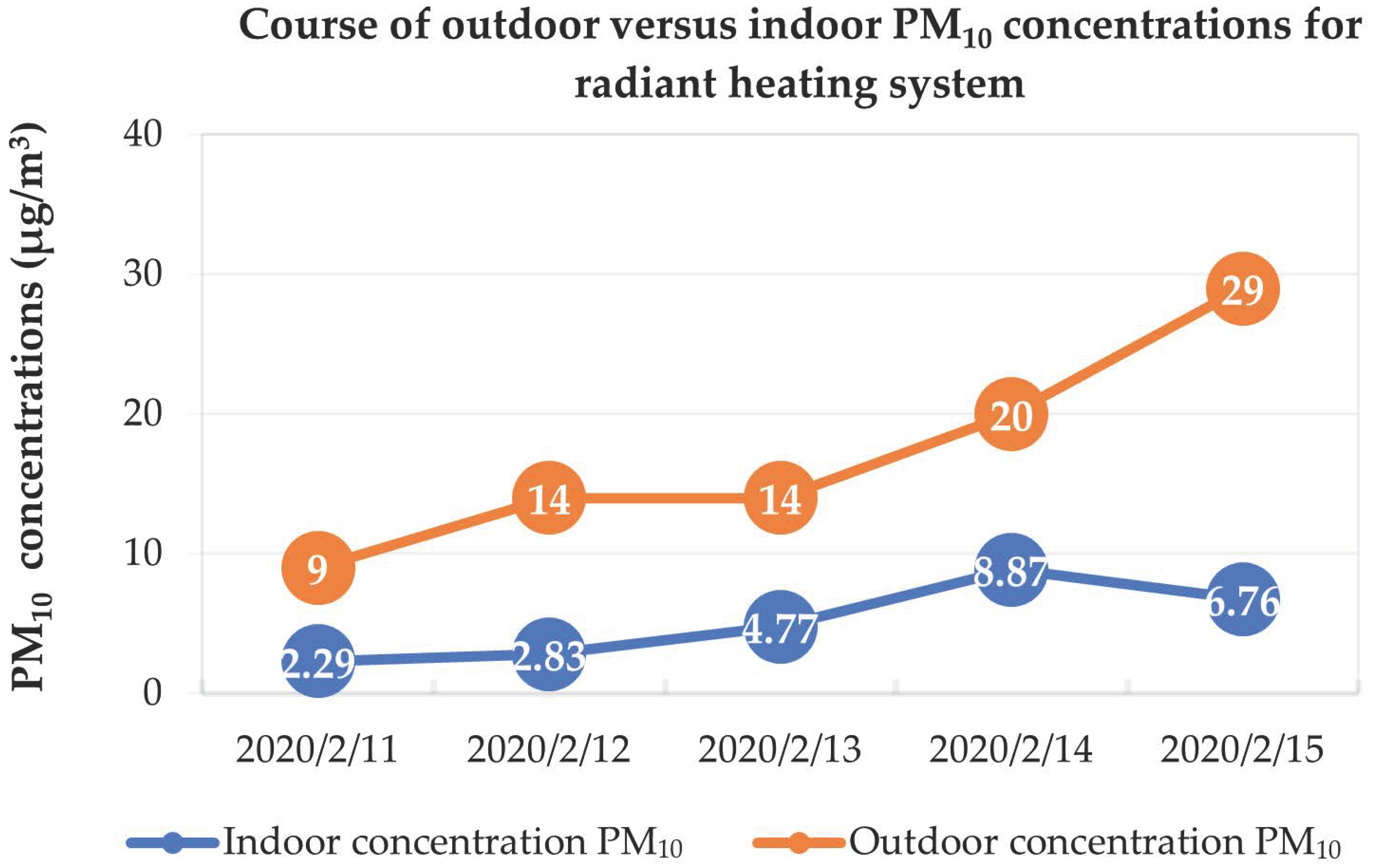
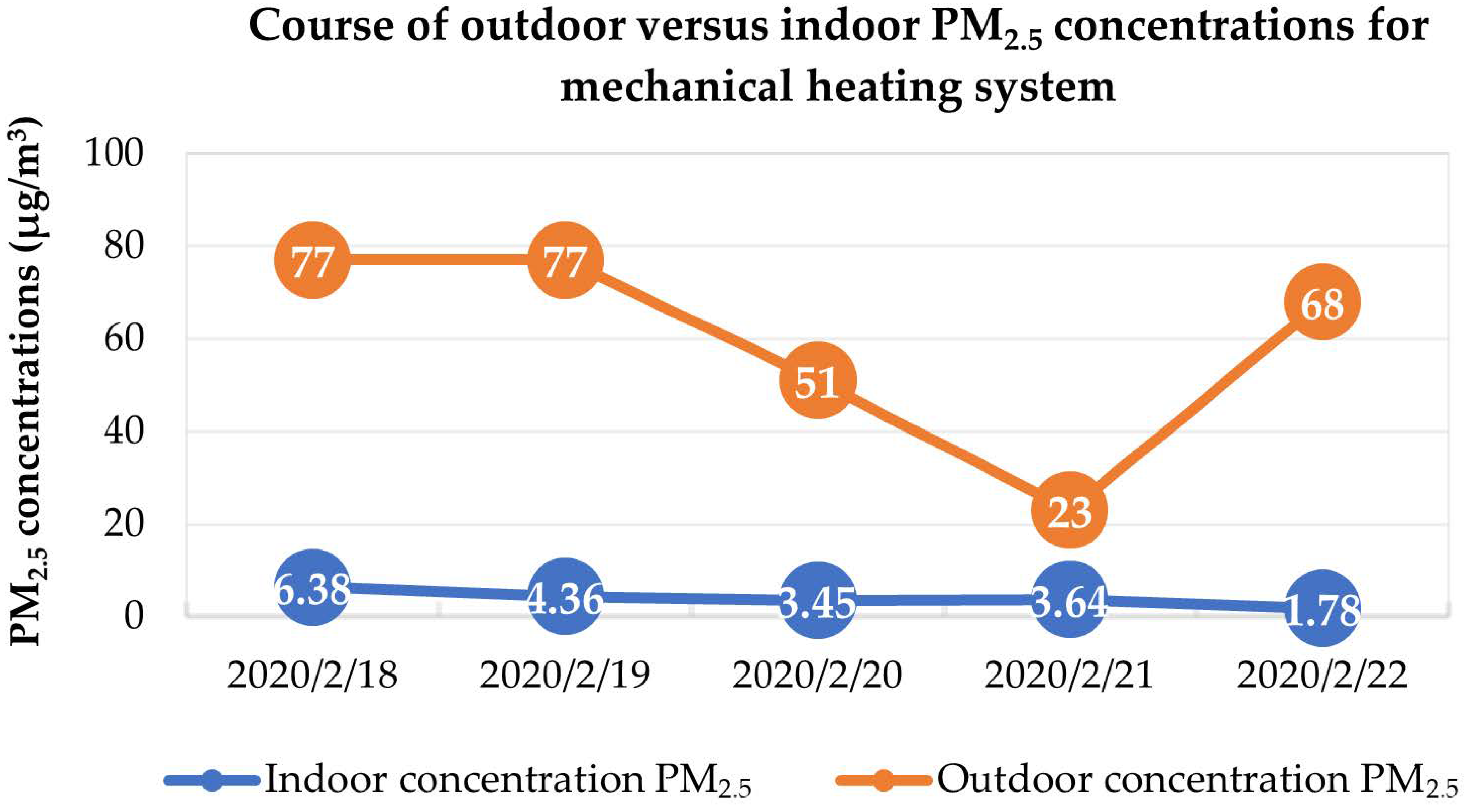
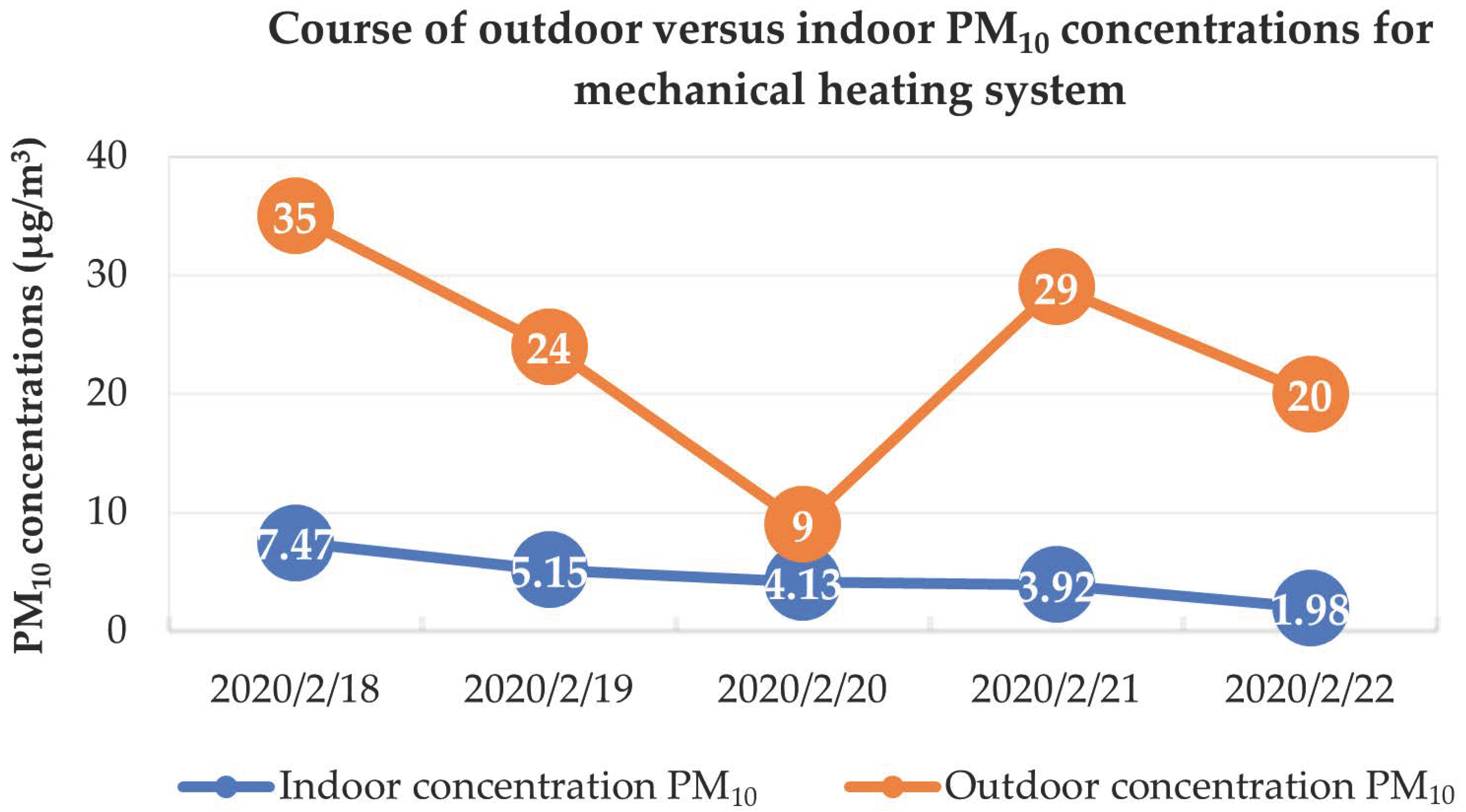
| Instrument | Sensor Type | Measuring Range | Accuracy | Resolution |
|---|---|---|---|---|
| Temperature—NTC | −20 to +70 °C | ±0.3 °C | 0.1 °C | |
| Humidity—capacitive sensor | 0 to +100% RH | ±2% RH (+2 to +98% RH) | 0% RH | |
| TESTO 435-4 | Air velocity—hot wire anemometer | 0 to +20 m/s | ±(0.03 m/s + 4% of m.v.) | 0.01 m/s |
| IAQ sensor (CO2) | 0 to +10,000 ppm CO2 | ±(75 ppm ± 3% of mv) (0 to +5000 ppm) ±(150 ppm ± 5% of mv) (+5001 to +10,000 ppm) | 1 ppm | |
| HANDHELD 3016 IAQ | Laser-diode light source and collection optics for particle detection | 0.3 to 10.0 μm | 50% at 0.3 μm; 100% for particles with sizes of >0.45 μm (per ISO 21501-4) | - |
| Floor Composition on the Second Floor | Roof Composition |
|---|---|
| tread layer (according to the purpose of the room) with a thickness of 20 mm | SIKAPLAN 15G foil, mechanically anchored in a thickness of 1.5 m |
| leveling screed thickness of 10 mm | mineral wool NOBASIL SPU with a thickness of 2 × 120 mm |
| reinforced concrete slab C25/30 (tempered concrete core) with a thickness of 250 mm | gradient layer of polystyrene-concrete PTB 350 with thicknesses of 50–120 mm |
| SIKA DS PE vapor barrier | |
| reinforced concrete slab C25/30 (tempered concrete core) with a thickness of 250 mm |
| RHS | MHS | |||||||
|---|---|---|---|---|---|---|---|---|
| Mean | Min | Max | SD | Mean | Min | Max | SD | |
| Air temperature (°C) | 22.89 | 22.33 | 23.51 | 0.32 | 24.26 | 23.09 | 25.24 | 0.58 |
| Relative humidity (%) | 24.50 | 21.06 | 27.27 | 1.40 | 25.10 | 22.61 | 28.8 | 1.68 |
| Air velocity (m/s) | 0.01 | 0 | 0.02 | 0 | 0.02 | 0 | 0.12 | 0.02 |
| CO2 (ppm) | 474 | 435 | 680 | 39.10 | 487 | 426 | 1002 | 71.75 |
| PM0.5 (µg/m3) | 2.52 | 0.27 | 7.70 | 1.80 | 1.93 | 0.16 | 4.88 | 1.30 |
| PM1.0 (µg/m3) | 4.03 | 0.48 | 12.39 | 2.82 | 3.05 | 0.27 | 7.56 | 2.01 |
| PM2.5 (µg/m3) | 4.70 | 0.66 | 14.21 | 3.16 | 3.62 | 0.34 | 8.76 | 2.28 |
| PM5.0 (µg/m3) | 5.16 | 0.98 | 14.97 | 3.20 | 4.05 | 0.40 | 10.59 | 2.46 |
| PM10 (µg/m3) | 5.27 | 1.05 | 15.03 | 3.18 | 4.20 | 0.43 | 13.40 | 2.55 |
| RHS | MHS | |||||||
|---|---|---|---|---|---|---|---|---|
| Mean | Min | Max | SD | Mean | Min | Max | SD | |
| Air temperature (°C) | 3.00 | 1.30 | 5.00 | 1.10 | 4.20 | 0.80 | 6.80 | 1.90 |
| Relative humidity (%) | 79.80 | 72.60 | 87.40 | 5.10 | 70.70 | 53.80 | 81.50 | 8.20 |
| Wind speed (m/s) | 6.10 | 3.70 | 9.50 | 1.90 | 8.40 | 4.20 | 13.00 | 3.40 |
| PM2.5 (µg/m3) | 51.10 | 27.00 | 76.00 | 21.00 | 54.30 | 23.00 | 77.00 | 19.10 |
| PM10 (µg/m3) | 21.00 | 9.00 | 35.00 | 8.70 | 20.00 | 9.00 | 35.00 | 9.20 |
| Surface Temperature (°C) | RHS | MHS | ||||
|---|---|---|---|---|---|---|
| Mean | Min | Max | Mean | Min | Max | |
| External wall | 22.51 | 22.40 | 22.62 | 23.80 | 23.61 | 23.99 |
| Internal wall adjacent to the office | 23.11 | 23.02 | 23.20 | 24.24 | 24.02 | 24.47 |
| Internal wall separating the office from the corridor | 23.08 | 22.99 | 23.16 | 24.27 | 24.03 | 24.51 |
| Ceiling | 23.60 | 23.52 | 23.68 | 24.55 | 24.30 | 24.81 |
| Floor | 23.65 | 23.58 | 23.72 | 24.34 | 24.24 | 24.45 |
| External wall close to the fan coil | 22.95 | 22.46 | 23.45 | 24.14 | 23.83 | 24.46 |
| Operative temperature | 23.10 | 24.28 | ||||
| Indoor | Outdoor | Indoor | Outdoor | |||
|---|---|---|---|---|---|---|
| PM2.5 | PM2.5 | I/O Ratio | PM10 | PM10 | I/O Ratio | |
| RHS | 1.61 | 76 | 0.02 | 2.29 | 9 | 0.25 |
| 2.13 | 27 | 0.08 | 2.83 | 14 | 0.20 | |
| 4.11 | 29 | 0.14 | 4.77 | 14 | 0.34 | |
| 8.35 | 30 | 0.28 | 8.87 | 20 | 0.44 | |
| 6.46 | 50 | 0.13 | 6.76 | 29 | 0.23 | |
| MHS | 6.38 | 77 | 0.08 | 7.47 | 35 | 0.21 |
| 4.36 | 77 | 0.06 | 5.15 | 24 | 0.22 | |
| 3.45 | 51 | 0.07 | 4.13 | 9 | 0.46 | |
| 3.64 | 23 | 0.16 | 3.92 | 29 | 0.14 | |
| 1.78 | 68 | 0.03 | 1.98 | 20 | 0.10 |
| RHS | MHS | |
|---|---|---|
| Toluene (µg/m3) | <9.96 | <9.96 |
| Xylenes (µg/m3) | <21.16 | <21.16 |
| Styrene (µg/m3) | <7.04 | <7.04 |
| Tetrachloroethene (µg/m3) | <15.19 | <15.19 |
Publisher’s Note: MDPI stays neutral with regard to jurisdictional claims in published maps and institutional affiliations. |
© 2022 by the authors. Licensee MDPI, Basel, Switzerland. This article is an open access article distributed under the terms and conditions of the Creative Commons Attribution (CC BY) license (https://creativecommons.org/licenses/by/4.0/).
Share and Cite
Nagy, R.; Krídlová Burdová, E.; Harčárová, K.; Vilčeková, S. Influence of the Heating System on the Indoor Environmental Quality—Case Study. Buildings 2022, 12, 1088. https://doi.org/10.3390/buildings12081088
Nagy R, Krídlová Burdová E, Harčárová K, Vilčeková S. Influence of the Heating System on the Indoor Environmental Quality—Case Study. Buildings. 2022; 12(8):1088. https://doi.org/10.3390/buildings12081088
Chicago/Turabian StyleNagy, Richard, Eva Krídlová Burdová, Katarína Harčárová, and Silvia Vilčeková. 2022. "Influence of the Heating System on the Indoor Environmental Quality—Case Study" Buildings 12, no. 8: 1088. https://doi.org/10.3390/buildings12081088
APA StyleNagy, R., Krídlová Burdová, E., Harčárová, K., & Vilčeková, S. (2022). Influence of the Heating System on the Indoor Environmental Quality—Case Study. Buildings, 12(8), 1088. https://doi.org/10.3390/buildings12081088








